Millions of engines. Is this reality, or echoes of the constant struggle between European, Japanese and American cars? Many automotive experts never tire of arguing about this. There is more that new, more improved models of units are constantly appearing on the market, and in practice they simply did not have time to show their real resource.
Nevertheless, there is a strong belief among the people that it is on Toyota cars that some of the most reliable engines in the world are installed. In particular, we are talking about the Toyota Avensis model, which has become one of the most popular in the world today.
It is easy to guess that the reason is not only in the current design, spacious salon and excellent driving characteristics. Engines of all three generations of Toyota Avensis are considered unique in their kind, which is why many connoisseurs good units would prefer to buy a used Toyota Avensis instead of a new car from another manufacturer.
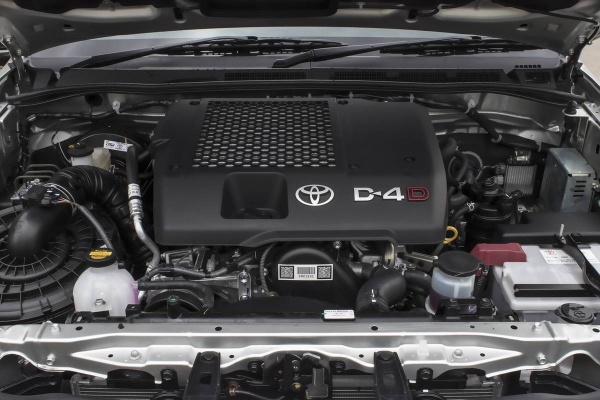
Pros of Toyota Avensis engines
There are a couple of reasons for the best Toyota engines to gain worldwide popularity:
- Well-organized engine compartment compared to other equally popular car brands. As a result, engine repair does not require disassembling a large number of components and removing many attachments just to make diagnostics or perform scheduled maintenance... It becomes cheaper as a result.
- Toyota Avensis engines are worthy of respect due to the fact that their development has always been well funded, because the engines really have excellent performance even in comparison with the units of more expensive cars.
- All indicators of reliability and durability are observed. These are: slow wear of friction parts, reliability of all units of the unit, excellent maintainability.

Review of the best Toyota Avensis engines
At one time, the Toyota Avensis model replaced the Carina E and Corona, which were popular at that time. The car under the new name was more relevant and modern. This large sedan was first seen in 19997. He had quite European appearance and was distinguished by excellent quality characteristics. The model became scandalous because in some European countries they refused to sell it. It was precisely in the competitiveness in comparison with more native brands. But in general, the car was distinguished by the following characteristics:
- excellent build quality;
- modern, fresh design;
- high level of comfort and safety;
- excellent quality of the unit.
First generation
Buyers of the first generation of Toyota Avensis had the opportunity to choose from three gasoline units with a volume of 1.6, 1.8 and 2.0 liters. And also a version of a 2.0-liter turbodiesel was presented. Accordingly, the 1.6-liter engine produces 1-9 horses, the 1.8-liter - also 109 liters. s, and the 2.0-liter unit - 126 Horse power... We can agree that at that time the indicators were more than impressive. In turn, the turbodiesel produces 89 liters. with.
In 2001, the exclusive Avensis Verso model was introduced to the market. This big car was recognized as the best among Toyota Avensis models in Australia. Today, its platform is considered more advanced than the second generation.
Important! All units of the first generation of Toyota Avensis had excellent build quality, they used Newest technologies, such as the variable valve timing system.

Second generation
The restyled version of Toyota Avensis, produced from 2003 to 2008, had the following engine options:
- 1.6 l at 109 HP;
- 1.8 l outstanding 127 HP;
- two-liter turbodiesel with 125 horses;
- later a 2.4-liter four-cylinder unit with 124 horsepower was added.
Important! The car's developers have been able to create a best-in-class suspension and a unique safety system. Japanese crash tests presented the model with all possible prestigious stars.
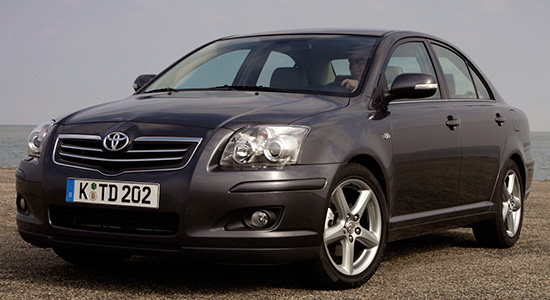
Third generation
At the 2008 Paris Motor Show, the third generation of the Toyota Avensis was presented. The release of the car continues to this day. Its engines are available in six variants. Three petrol and the same diesel.
This short review dedicated to common engines, in order to make it as easy as possible for you to choose the model you need. The characteristics of the most famous Japanese engines will be described below, ranging from reliability to economy. However, it should be noted that the data are compiled only on statistics, so some models may not correspond to it. So, if it is written about your engine as "problematic", you can safely object and refute the information.
TOYOTA ENGINES
"The simplest Japanese engine"
Engines of the A series are massively exploited in our country and, in terms of prevalence, share, perhaps, the championship with the S series, and in the conditional reliability rating they can be placed in third place. Moreover, they have good maintainability and widely available spare parts. Installed on cars of classes "C" and "D" (families Corolla / Sprinter, Corona / Carina / Caldina).
4A-FE is the most common engine.
5A-FE- version with reduced working volume
7A-FE- a more recent modification with increased volume and improved traction at the bottom (7A-FE LB)
In the optimal production version, the 4A-FE and 7A-FE went to the Corolla family. However, when installed on Corona / Carina / Caldina vehicles, they received a LeanBurn-type power system, which helps to save Japanese fuel during quiet driving and in traffic jams. It should be noted that here the Japanese have pretty much "spoiled" our ordinary consumer - some owners of these engines are faced with the so-called "LB problem", which manifests itself in the form of characteristic failures at medium speed, the cause of which cannot be properly established and cured - or the poor quality is to blame. local gasoline, or problems in the power supply and ignition systems, or all together.
A small additional disadvantage is the formal difficulties with adjusting the clearances in the intake valves, but in general it is quite convenient to work with these engines.
JZ series engines
The top series of the last decade, in different variations, is installed on all Toyota rear-wheel drive passenger models.
1JZ-GE is the base engine for the Mark II and Crown families.
2JZ-GE - increased volume option.
1JZ-GTE, 2JZ-GTE - turbocharged versions of high power (without a 300-320 hp limiter).
1JZ-FSE, 2JZ-FSE - Direct injection engines, endowed with all the problems of the D-4 to the same degree, if not more, than the 3S-FSE.
There are no significant drawbacks, they are very reliable with proper operation and proper care. Since the spark plugs are difficult to access, they are forced to use (at least in the central cylinders) "platinum". Minus - the drive of all attachments with one long belt with a hydraulic tensioner (moreover, American-made and not distinguished by its durability). After 1995-96, the engines received the VVT-i system.
MZ series motors
V-shaped sixes are relatively recent development for large front wheel drive vehicles class "E" (Camry-Gracia, Camry-Windom) and parquet jeeps based on them.
1MZ-FE, 2MZ- F E - designed to replace the VZ series. Judging by the reviews, some of the shortcomings were indeed corrected, although the sample is still small.
Early versions had a traditional gas distribution, then there was VVT-i system... The purely aluminum construction (the first mass-produced Toyota engine of this type) is alarming - at least similar engines from other manufacturers demonstrate "no" maintainability, high vulnerability to overheating, sensitivity to low temperatures (in other words, they burst in our winter ...). Yes, one more thing - most of the MZ series engines are assembled by TMMK (Toyota Motor Manufacturer Kentucky), that is, by the Americans, and only then are imported to the metropolis.
Engines "Nissan"
RB24S - This is a relatively rare engine as it was not produced for the Japanese domestic market. They were installed on left-handed Nissan Cefiro exported from Japan. Mechanically it is made from RB30E head, RB25DE / DET block and RB20DE / DET crank with 34mm height pistons. This engine used carburetors instead of an injection system. fuel nissan ECCS. The general modification should match the twin head from other RB series engines while maintaining the carburetor setting. The standard single chamber form produced 141 hp. at 5000 rpm and 197 Nm of torque at 3000 rpm.
RB25 - 2.5 L
The RB25 engine was produced in four forms:
RB25DE - naturally aspirated Twin-CAM 140 kW / 190 hp (180 - 200hp) @ 6000 rpm, 255 Nm (26.0 kgf m) at 4000 rpm)
RB25DET - Twin-CAM TURBO (T3 Turbo) (245 to 250 HP and 319 Nm)
NEO RB25DE - naturally aspirated Twin-CAM 147 kW / 200 hp @ 6000 rpm, 255 N m (26.0 kgf m) at 4000 rpm)
NEO RB25DET - Twin-CAM TURBO (206 kW (280 HP) @ 6400 rpm, 362 Nm (37.0 kgf m) at 3200 rpm)
RB25DE and DET engines produced from August 1993 also had NVCS (Nissan Variable Cam System) for the intake cam. This gave the new RB25DE more power and torque with more low revs than the previous model. From 1995 both the RB25DE and RB25DET had revised electrical systems, and the turbocharger on the RB25DET had a plastic compressor wheel rather than aluminum. Generally these engines are referred to as Series 2 engines. The most obvious change to the system was the introduction of ignition coils with built in electrodes - ignitors, so the coil ignitor electrode that was on previous models was not used. Other changes: various air flow meter, engine ECU, camera angle sensor and throttle position sensor.
Diesel Engines TD Series on models TERRANO / PASFINDER, SAFARI / PATROL, CARAVAN / URVAN were originally developed as engines for boats (and marine engines in general, they are more reliable compared to automobile ones) and have a gear drive of the gas distribution mechanism (in fairness, I will say that the timing gear drive is also found on Toyota diesel 3V). If there are problems with these engines, they mainly concern fuel system as for any diesels.
The disadvantages of NISSAN engines include greater difficulty in repair and maintenance, compared to TOYOTA. This is mainly due to the fact that under the hood of the Nissan, everything is very tightly "packed".
The most reliable Nissan engines are RB20 / 25/26, SR18 / 20, TD23 / 25/27/42, GA13 / 15/16.
Engines "SUBARU"
Most of the engines of this company have an opposed layout, which provides very high strength and rigidity of the cylinder block, but at the same time makes the engine difficult to repair. Older engines, the EA82 series are renowned for their reliability. Newer Series Engines EJ (EJ15, EJ18, EJ20, EJ25, EJ30) installed on various SUBARU models from 1989 to the present, are less reliable, but in principle, these are pretty good engines. They are distinguished by a moderate degree of forcing and the absence of variable valve timing, direct fuel injection systems, etc. By the way, diesel engines are not installed on SUBARU cars, as well as on HONDA. According to the requirements for the quality of oil and fuel, SUBARU engines are approximately on the level of TOYOTA.
Engines "Honda"
ZC series motors
For ZC motors, there is no concept of "subtlety of service". It is a pity that there are few of them left, because these motors surprise with their endurance to this day. They are capable of running on any oil, on any gasoline. The ZC engine, in which at least some compression remains, will start up to -20 degrees, even with four old different candles... The unpretentiousness of the ZC (as well as the entire D-series) amazes and commands respect.
Applicability: Civic, Domani, Ingtegra, CRX and others.
B series motors
Twin-shaft B-series engines are one of the most common engines that "lived" in the engine compartment of Honda cars at the end of the last millennium. Most of the models were equipped with the most famous version - B20B. These cars include Honda's "greatest hits" - the CR-V and StepWGN, as well as the lesser-known Orthia and S-MX. In this review, we will look at the features of engines such as the B20B, or B16B, touch on the issues of reliability and maintenance complexity.
The uniqueness of the B-series is that only it managed to combine the truly civilian characteristics of the B20B, and the fantastic athletic abilities of the B16B or B18C. The most amazing thing is that B-series engines can easily "cross" within the range, which gives excellent end results... This is used by many breeders of tuners, creating hybrids that surpass the power of turbo engines of competitors.
And in order for your car to be protected, we order sectional doors
This quick overview focuses on common Toyota engines 1990-2010s. Data is based on experience, statistics, feedback from owners and repairers. Despite the criticality of the assessments, it should be remembered that even a relatively unsuccessful Toyota engine is more reliable than many creations domestic auto industry and stands at the level of most of the world's samples.
Since the beginning of the mass import of Japanese cars into the Russian Federation, several conventional generations of Toyota engines have already changed:
- 1st wave(1970s - early 1980s) - now reliably forgotten motors of the old series (R, V, M, T, Y, K, early A and S).
- 2nd wave(the second half of the 1980s - the end of the 1990s) - Toyota classics (late A and S, G, JZ), the basis of the company's reputation.
- 3rd wave(since the late 1990s) - “revolutionary” series (ZZ, AZ, NZ). Characteristics- light-alloy ("disposable") cylinder blocks, variable valve timing, timing chain drive, implementation of ETCS.
- 4th wave(since the second half of the 2000s) - an evolutionary development of the previous generation (ZR, GR, AR series). Special features - DVVT, Valvematic versions, hydraulic lifters. Since mid-2010s - re-introduction of direct injection (D-4) and turbocharging
"Which engine is the best?"
It is impossible to single out the best engine in the abstract, if you do not take into account base car on which it was installed. The recipe for creating such a unit is, in principle, known - an inline six-cylinder is needed gasoline engine with a cast iron block, as large as possible and as little forced as possible. But where is such an engine and on how many models was it installed? Perhaps the closest toyotans came to the "best engine" at the turn of the 80s and 90s with the 1G engine in its various variations and with the first 2JZ-GE. But…
First, structurally, the 1G-FE is not perfect on its own.
Secondly, being hidden under the hood of some Corolla, it would serve there forever, satisfying almost any owner with both vitality and power. But it was actually installed on much heavier cars, where two liters of it were not enough, and work at maximum efficiency affected the resource.
Therefore, we can only say about the best engine in its class. And here the "big three" is well known:
4A-FE STD type'90 in class "C"
For the first time toyota 4A-FE was released in 1987 and did not leave the assembly line until 1998. The first two characters in its name indicate that this is the fourth modification in the "A" series of engines produced by the company. The series began ten years earlier, when the company's engineers set out to create a new engine for Toyota Tercel, which would provide more economical fuel consumption and better technical performance. As a result, four-cylinder engines with a capacity of 85-165 hp were created. (volume 1398-1796 cm3). The motor housing was made of cast iron with aluminum heads. In addition, the DOHC gas distribution mechanism was used for the first time.
It should be noted that the resource 4A-FE until the bulkhead (not overhaul), which consists in replacing valve stem seals and worn out piston rings, is approximately 250-300 thousand km. Much, of course, depends on the operating conditions and the quality of service of the unit.
The main goal in the development of this engine was to achieve a reduction in fuel consumption, which was achieved by adding an EFI electronic injection system to the 4A-F model. This is evidenced by the attached letter "E" in the marking of the device. The letter "F" denotes standard power engines with 4-valve cylinders.
The mechanical part of the 4A-FE motors is designed so competently that it is extremely difficult to find an engine of a more correct design. Since 1988, these engines have been produced without significant modifications due to the absence of design defects. The engineers of the auto enterprise were able to optimize the power and torque of the 4A-FE internal combustion engine in such a way that, despite the relatively small volume of the cylinders, they achieved excellent performance. Together with other products of the "A" series, motors of this brand occupy leading positions in reliability and prevalence among all similar devices manufactured by Toyota.
It is not difficult to repair the 4A-FE. A wide range of spare parts and factory reliability give you a guarantee of operation for many years. FE engines are free from cranking drawbacks connecting rod bearings and leakage (noises) in the VVT clutch. The very simple adjustment of the valves is of great benefit. The unit can run on 92 gasoline, consuming (4.5-8 liters) / 100 km (due to the mode of operation and the terrain)
Toyota 3S-FE
3S-FE in class "D / D +"
The honor to open the list falls to the Toyta 3S-FE motor - a representative of the well-deserved S series, which is considered one of the most reliable and unpretentious units in it. A two-liter volume, four cylinders and sixteen valves are typical figures for mass engines of the 90s. Drive unit camshaft belt, simple distributed injection. The engine was produced from 1986 to 2000.
Power ranged from 128 to 140 hp. More powerful versions of this engine, the 3S-GE and the turbocharged 3S-GTE, inherited a good design and a good resource. The 3S-FE engine was installed on a number of Toyota models: Toyota Camry (1987-1991), Toyota Celica T200, Toyota Carina (1987-1998), Toyota Corona T170 / T190, Toyota Avensis (1997-2000), Toyota RAV4 (1994- 2000), Toyota Picnic (1996-2002), Toyota MR2, and turbocharged 3S-GTE also on Toyota Caldina, Toyota Altezza.
Mechanics note the amazing ability of this engine to withstand high loads and poor service, the convenience of its repair and the overall thoughtfulness of the design. At good service such motors exchange a mileage of 500 thousand kilometers without overhaul and with a good margin for the future. And they know how not to bother the owners with minor problems. 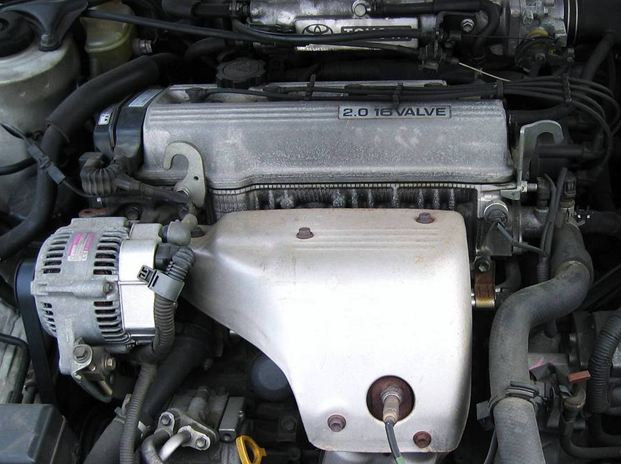
The 3S-FE engine is considered one of the most reliable and durable gasoline fours. For power units It was quite ordinary in the 90s: four cylinders, sixteen valves and a 2-liter displacement. Camshaft drive by belt, simple multipoint injection. The engine was produced from 1986 to 2000.
Power ranged from 128 to 140 "horses". The 3S-FE engine has been installed on a number of popular Toyota models including: Toyota Camry, Toyota Celica, Toyota MR2, Toyota Carina, Toyota Corona, Toyota Avensis, Toyota RAV4, and even Toyota Lite / TownACE Noah. More powerful versions of this engine, such as the 3S-GE and the turbocharged 3S-GTE, installed on the Toyota Caldina, Toyota Altezza, inherited the successful design and good resource of the progenitor.
A distinctive feature of the 3S-FE engine is its good maintainability, the ability to withstand high loads and, in general, reasonable design. With good and timely maintenance, the motors can easily run 500,000 kilometers without overhaul. And the margin of safety will still remain.
1G-FE in class "E".

The 1G-FE engine belongs to the family of in-line 24-valve six-cylinder internal combustion engines with a belt drive on one camshaft. The second camshaft is driven from the first through a special gear ("TwinCam with a narrow cylinder head").
The 1G-FE BEAMS engine is built according to a similar scheme, but has a more complex design and cylinder head filling, as well as a new cylinder-piston group and crankshaft... From electronic devices the internal combustion engine has a system of automatic variable valve timing VVT-i, electronically controlled throttle ETCS, DIS-6 contactless electronic ignition and ACIS intake manifold control system.
The Toyota 1G-FE engine was installed on most rear-wheel drive cars of the E class and on some models of the E + class.
A list of these cars with an indication of their modifications is given below:
- Mark 2 GX81 / GX70G / GX90 / GX100;
- Chaser GX81 / GX90 / GX100;
- Cresta GX81 / GX90 / GX100;
- Crown GS130 / 131/136;
- Crown / Crown MAJESTA GS141 / GS151;
- Soarer GZ20;
- Supra GA70
More or less reliably, we can only talk about the "resource before the bulkhead", when a mass series engine, like A or S, will require the first serious intervention in the mechanical part (not counting the replacement of the timing belt). For most engines, the bulkhead falls on the third hundred of the run (about 200-250 thousand km). As a rule, this intervention consists in replacing worn or stuck piston rings, and at the same time the valve stem seals, that is, it is just a bulkhead, and not overhaul(the geometry of the cylinders and the hone on the walls of the cylinder block are usually preserved).
Andrey Goncharov, expert of the heading "Car repair"
In the world of motorists, there are legends about unbreakable engines. Many even claim that they can confirm the reliability of this or that motor with a range of half a million to a million kilometers, even though they have been watching it for only a few years. In fact, there are engines of a million, we have compiled a list of cars for you. Auto repair shops with extensive experience helped to compile this list. And since the world auto industry has tried its best in recent decades, there are a lot of such cars.
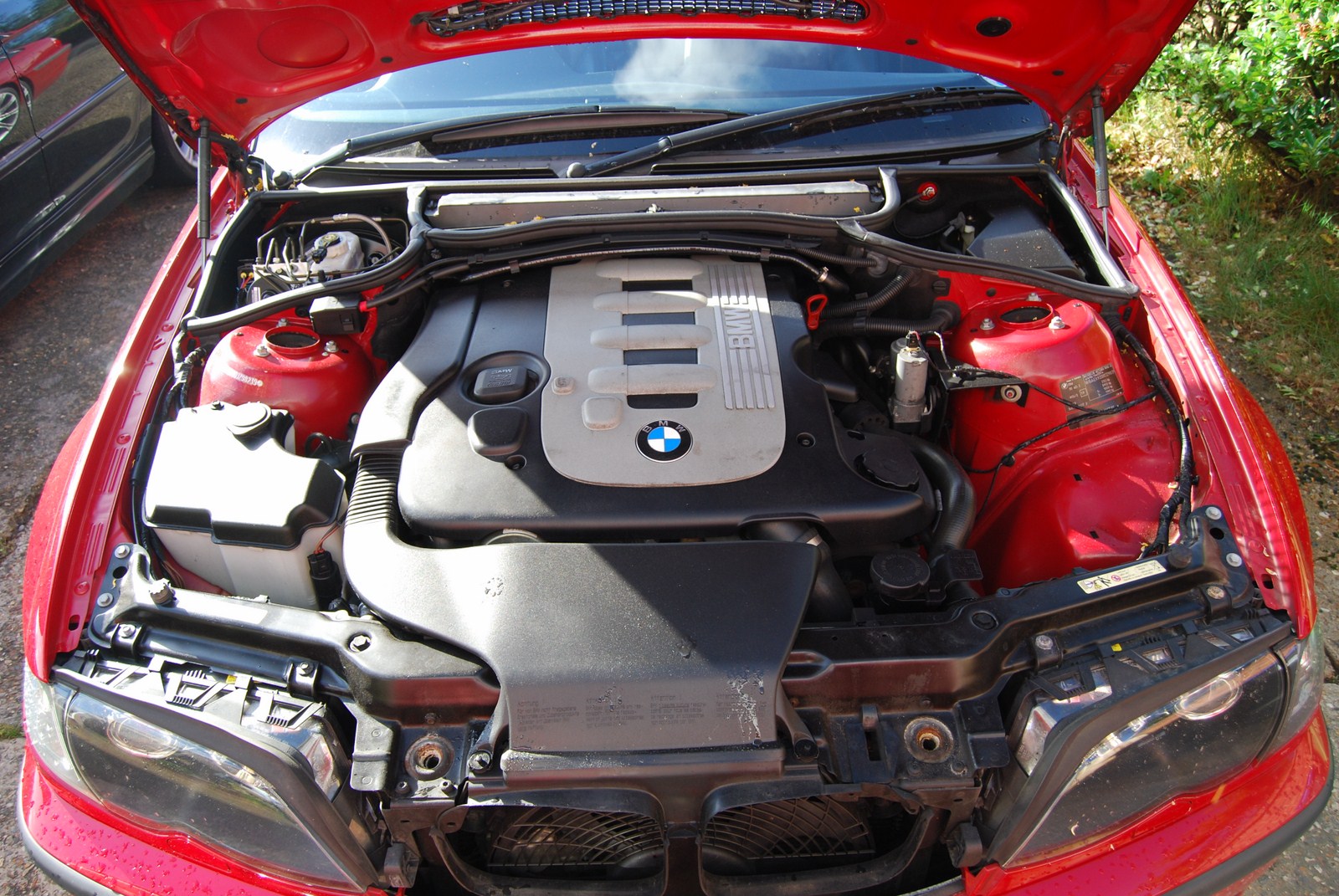
Engine - millionaire from BMW
The reliability of the engine is determined by the following indicators:
- durability is determined by the rate of wear of motor parts;
- reliability, that is, the frequency of any failures that led to the termination of operation;
- persistence, that is, resistance to the effects of various external factors at moments of inactivity;
- maintainability - can it be repaired.
This list raises a lot of questions. Is 1 million km a mileage after which the engine parts are completely worn out? Or should there be no refusals during this time? Or maybe it is so maintainable, then a car with it will cover 1 million kilometers without problems?
In this case, we must also talk about the limiting state. It is determined by the impossibility of further operation for technical, economic reasons or the creation of unsafe situations for the environment. This approach suggests that the engine can travel 1 million km with adequate maintenance.
A million-plus engine is a machine endowed with huge reserves of strength.
Speaking of millionaires, they often recall cars produced in the 80s and 90s, because they are still actively used. Their safety margin is so great that they pass the first 500 thousand km without overhaul. Modern models are produced in harsh environmental and marketing conditions. Motors of a smaller volume are produced, which leads to forcing and the use of turbo-charging. And this shortens the life of the motor several times.
The best engines of millionaires: what are they?
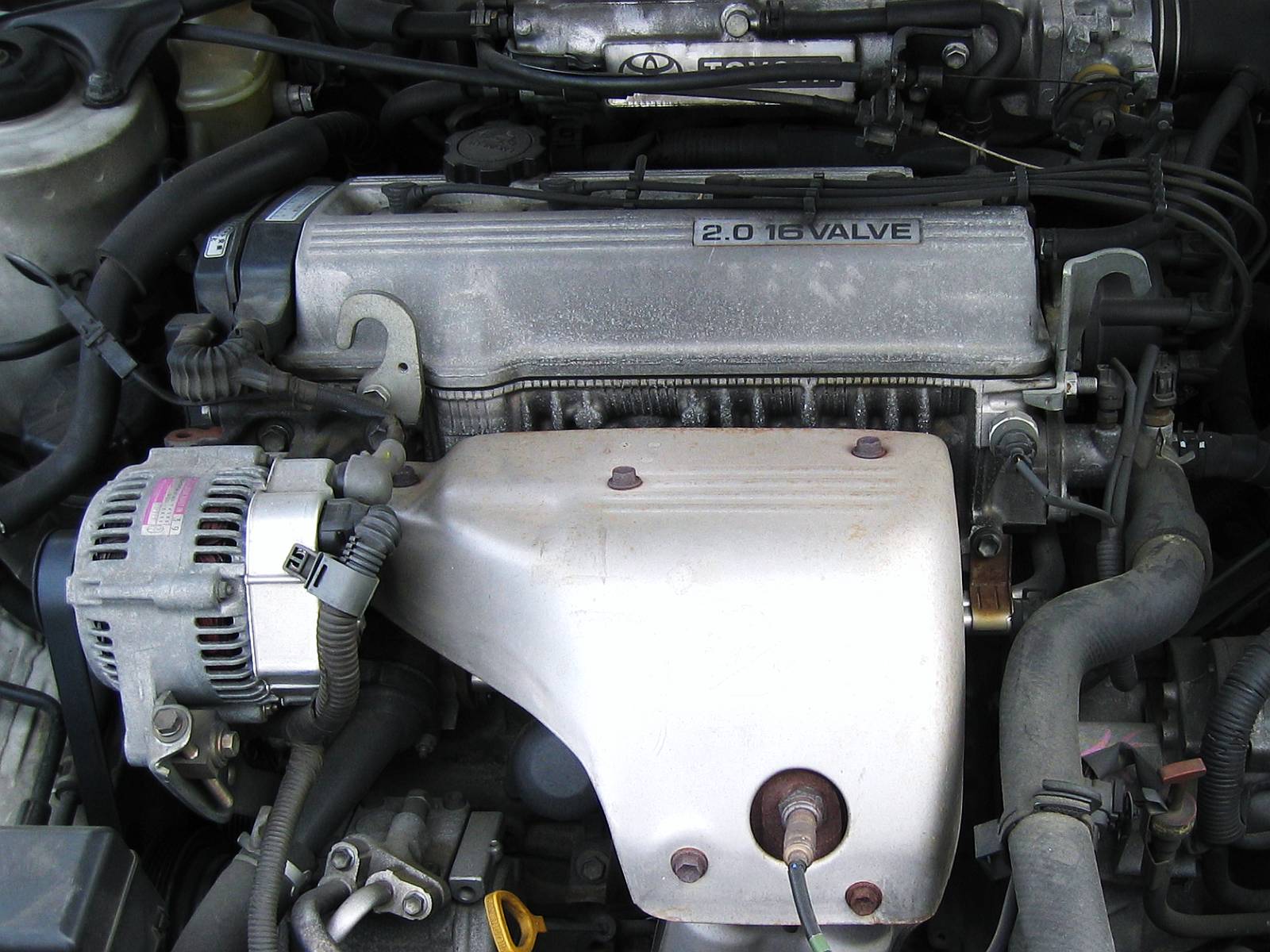
Engine millionaire Toyota 3S-FE
- Diesel have gained a reputation for being reliable and durable engines. And they really have a good margin of safety, despite the fact that their design is quite simple. Unkillable motors are endowed with Mercedes-Benz OM602, BMW M57.
- Gasoline inline "fours" rival diesels in popularity. However, their design is a little simpler, besides, even in the most severe frosts, gasoline will not freeze. Representatives of this category include Toyota 3S-FE, Mitsubishi 4G63, Honda D-series, Opel 20ne.
- Gasoline inline "sixes" are distinguished by simplicity of design, power and absence of vibration. Cars with engines of this category are represented quite widely - Toyota 1JZ-GE and 2JZ-GE, BMW M30 and M50.
- V-shaped "eights"- these are large units that cannot boast of a super-long period of operation. However, all these statements should not be applied to the "Americans". There are not so many models with V-shaped units that can easily cross the half-million threshold, a typical representative is the BMW M60.
What cars have a million-strong engine?
But the list of vehicles with million-strong engines is not so small. Not so far has gone such a time when the world was literally captivated by the desire to equip a car with an indestructible engine. Moreover, certain companies lived with this desire until the new millennium. Millions of engines in which cars? The list goes on:
- Mercedes-Benz OM602.
- BMW M57.
- Toyota 3S-FE.
- Mitsubishi 4G63.
- Honda D-series.
- Opel 20ne.
- BMW M60.
- Toyota 1JZ-GE and 2JZ-GE.
- BMW M30.
- BMW M50.
Millions are the most reliable engines of our time
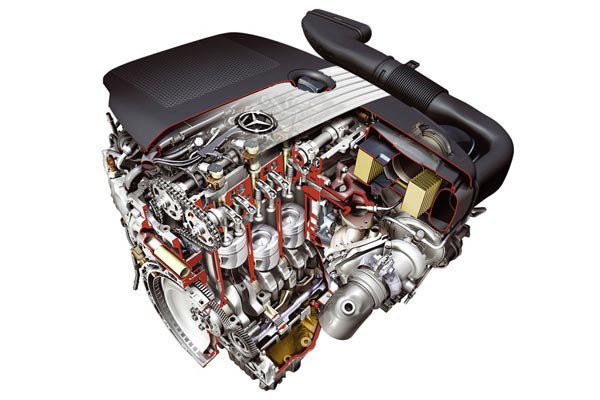
Diesel engine Mercedes OM651
Are "millionaires" irretrievably forgotten? No, even though today "disposable" cars have become fashionable. Ride 3-4 years, sold and - to the salon for a new "swallow". What is there to hide? In fact, there are unsuccessful models, but not all of them. People exploit vehicle for 5-7, and sometimes even 10 or more years, and someone buys a car at all "from hand".
List modern engines millionaires are quite wide.
In this respect, millionaires are the most reliable engines of our time. But which one to choose and not miscalculate? Leaders can be distinguished by class. It is worth saying that the more expensive models are not well suited for tough operation, but you shouldn't ignore them either, because there are really decent options.
- Small class represented by domestic and foreign machines. They are practical and not burdened with different electronics and unnecessary functions. The undisputed leader in this category can be called K7M from Renault, the VAZ-21116 and Renault K4M are slightly behind it.
- Middle class represented by such names Z18XER, Renault-Nissan MR20DE / M4R, series of engines from Hyundai / Kia / Mitsubishi G4KD / 4B11.
- Junior business class... The models mentioned above are popular here, as well as the more powerful Toyota 2AR-FE, G4KE / 4B12 from Hyundai / Kia / Mitsubishi.
- Senior business class Are cars that cannot be called cheap. Motors differ in complexity and power, but they are not endowed with special endurance. The leaders in this category are Toyota 3.5 series 2GR-FE and 2GR-FSE, Volvo B6304T2, Infiniti VQVQ37VHR. Can't pass by diesel Mercedes E class in the back of W212 and with the OM651 engine.
- Executive class cannot be cheap, because cars are stuffed with the latest innovations to overflowing. It is impossible to name the best among them. For example, the Germans are famous for their special attitude to diesel engines and try to make them reliable (a vivid example is the Mercedes engine with a million-strong), while the Koreans and Japanese focus their work primarily on gasoline ones.
Modern engines of one million people continue to be produced by leading manufacturers today. The trends have changed a little, because if earlier the first lines of the ratings were occupied by European and American manufacturers, today Japanese engines with a million people are entering the arena.
Features of operation
The mileage of the motor in any case depends on the characteristics of its operation. For example, in countries with harsh climates, long idle traffic and fast driving wear out parts much faster. And if you choose a Toyota millionaire engine for a taxi, then everything will change in better side... The taxi is almost constantly in motion, which is much better than sitting in traffic jams for many hours.
Regular maintenance of machine parts can extend the service life by several years or decades. Care includes correct replacement oils, use of high-quality fuel.
The millionaire engine is interesting only hypothetically. After all, if you spend simple mathematical calculations, it will become clear that the car will cover 1 million km in 37-40 years. And during this time, it crumbles, although the engine continues to work.
The ten most popular engines of millionaires are in the video on our website!
Back in the last century, it was believed that the larger the engine volume, the better, better, more reliable, more powerful it is. Time goes by, everything changes. Today the volume of the engine has faded into the background. The technologies that are used in our time (turbines, compressors, mechanical blowers) made it possible to remove unprecedented power from minimal volumes, this is confirmed by the rotary motor, which is installed on the RX8, but more on that later. Japan 2008 was recognized as the largest car manufacturer in the world. According to Warranty Direct in 2014, three manufacturers from Japan entered the top five most reliable engines at once, which is not strange if you have such long-term traditions and experience in the production of internal combustion engines.
5 legends of engineering
1) 2JZ-GTE
One of the most popular Japanese motors produced from 1991 to 2002 (pictured above). This engine was specially developed for the Toyota Supra RZ as opposed to the Nisan internal combustion engine. This inline-six has a 3.0-liter twin turbocharging and 451 Nm of torque. They are famous for their great resource and safety factor. The engine block is made of cast iron, the head of the block is made of aluminum, so in stock it can withstand a side load of up to 1000 hp. without internal interference. It can rightfully be called the most popular and affordable Japanese engine for tuning (especially among drifters).
2) RB26DET
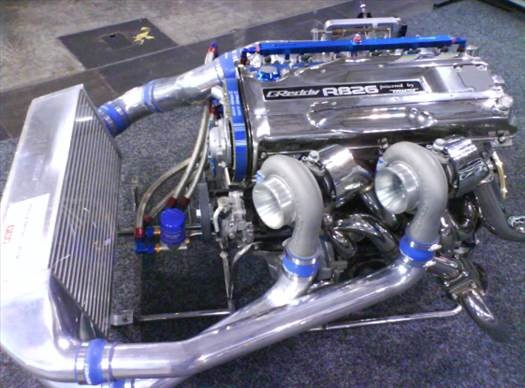
6-cylinder, in-line 2.6 liter engine manufactured by Nissan. Produced from 1985 to 2004. It was intended for installation on the Nissan Skyline GT-R. In stock, the power reached 330-350 hp. and 392 N / m of torque, although only 280 hp were declared in those characteristics)) - this was due to the agreement of the manufacturers, who agreed not to exceed this power threshold. This engine is widely known for its performance and extremely high tuning potential as it has two turbochargers. Can withstand 600 hp. without modifying the internals of the internal combustion engine.
3) 13B-REW
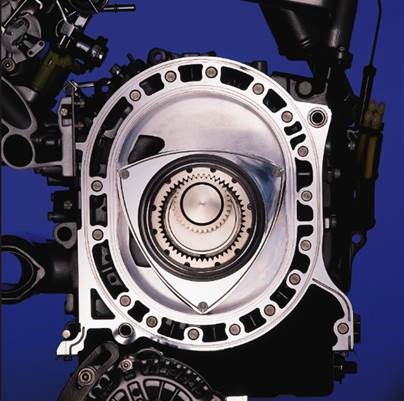
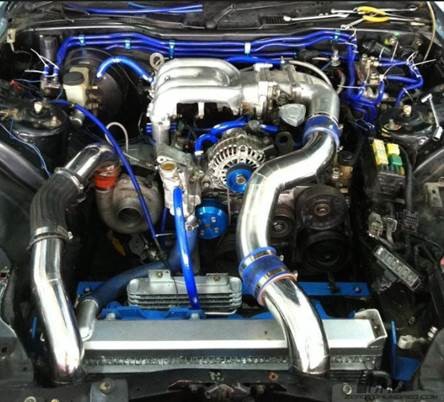
It can be considered a truly innovative solution in mechanical engineering. This engine serially produced only on the Mazda RX-8, it was previously installed on the previous model RX-7. Japanese engineers managed to remove 190 hp from 1 liter of working volume. power. The maximum volume of the internal combustion engine was only 1.3 liters and was equipped with two turbines standing one after the other. The first turbine starts to operate at low speeds (approximately from 1800 rpm) so that a "turbo lag" does not appear on them. The second turbine starts up at 4000 rpm. which made it possible at any time to obtain the maximum torque that the motor can produce. One of the main advantages of this motor is a low center of gravity and an even distribution of weight along the axles of the vehicle. It has great potential for improvement, but at the same time it is considered very moody and partially unreliable.
4) SR20DET
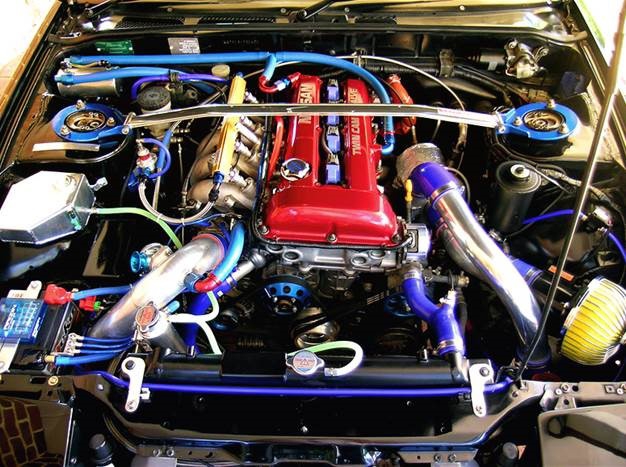
The SR20DET engine was produced from 1991 to 2002 and had several different variants in different years of production and for different models Nissan. The 2.0-liter inline four-cylinder engine with an installed turbocharger produces a modest 245 hp, but at the same time it "turns" to maximum power and torque at an unprecedented speed.
Favorite motor of novice Japanese and European drifters)) Low level compression ratio "8.5" in the cylinders made it possible to easily increase the boost of the turbo supercharger to 1 bar without much intervention in the internal combustion engine itself, which made it possible to use a budget engine with excellent technical characteristics for all sorts of tasks. The most successful car with this engine can rightfully be considered the Nissan Silvia S15.
5) 4G63T vs EJ20
Two eternal competitors in the world rally championship, especially in the early 2000s. The competition between Mitsubishi and Subaru allowed them to bring their engines to perfection.
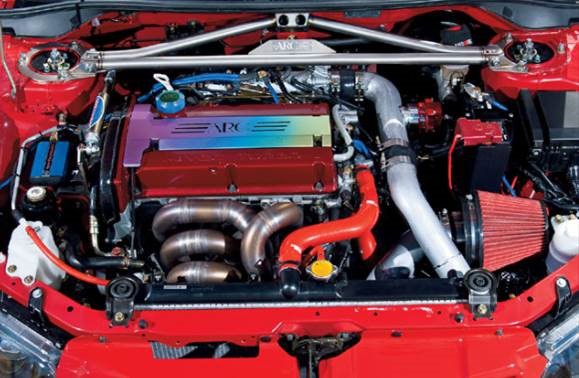
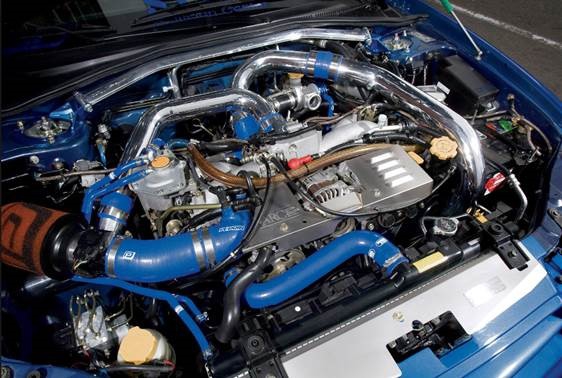
Legendary motors of this series were installed on Mitsubishi lancer Evolution from the first to the ninth generation. From the factory, it had a 2.0 capacity of 343 hp. (with a boost of 0.8 bar) and 382 N / m of torque with a turbocharger and DOHC valve timing. In these motors technology and simplicity of design are ideally combined. Nowadays, Evolution cars with this engine are an icon in rally sports as they have been tested in harsh conditions. "Brought" many awards from Mitsubishi for many decades in this motor sport.
Four-stroke, four-cylinder boxer engine with a horizontal arrangement of cylinders due to its design and a low center of gravity made it possible to give cars in which clarity and responsiveness in control were directly set. The volume of this internal combustion engine is 2.0 liters and has 225 hp. In the circles of motorists, he was named as "Hedgehog", has established itself as a productive and reliable motor and its tuning potential is even higher than that of the 2.5-liter EJ25, primarily due to the thicker cylinder walls. It is also worth adding that all engines for the "hottest" versions of Subaru are named with the abbreviation WRX STI and were equipped with forged pistons. It is not prejudiced that in rally championships cars with a hedgehog won even more awards and prizes than 4G63T.


